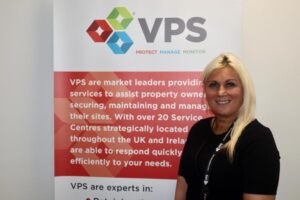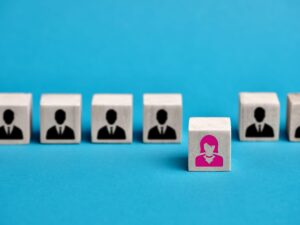In a new series for SHP, we speak to professionals working in or around health and safety to start conversations that go beyond the day job, sharing individuals’ challenges and ideas for the profession. In our first interview, Assistant Editor, Rhianna Sexton spoke to Carolyn Smith, Director of Health and Safety at VPS, about obstacles, achievements and gender diversity in health and safety.

Carolyn Smith, Director of Health and Safety at VPS
SHP: Hi Carolyn, could you tell us about how you got into health and safety?
Carolyn Smith (CS): I worked for a company called Speedy Hire and I started off as a hire controller. One day I was asked to start a monthly check and I really liked it. I made some progression and when a new safety director came in, he was told about my interest and thought I would be ideal for his team. I went into that team part time – studying whilst having small children – I passed the qualification and was invited to join the team full time.
I just wanted to make a difference, I could see it would be a challenge, but I wanted to do it and I ended up becoming the only female in Speedy that got chartered status.
I’ve always been risk-averse as a person anyway, so to see things in the workplace and them being continually ignored or pushed to one side because the person that was doing it didn’t really have the time, didn’t sit right with me – I could just see that I was making a difference.
It was simple things to start off with, I would see there were leaves on the stairs and people were slipping, a quick fix. Ultimately, I care about people, I’m quite an empathetic person and I knew it was the right thing to do.
SHP: Did you feel like you faced any negativity or challenges being the first female to get chartered status?
CS: I have at times. Some companies are like old boys’ clubs with golf days, drinking days and I didn’t fit in or like it.
When I got NEBOSH qualified, I challenged something to do with a risk assessment and someone more senior than me was actually quite sexist and told me I couldn’t change the world just because I got this qualification.
I told him I wasn’t trying to change the world, but I wanted to change the world that I’m in.
I went to another manager and told them the risk assessments we were using were not good enough and they were pleased because someone finally had the guts to say it.
I think starting from the ground up, I got to know the people. So, I cared. I could have banter with people but as my role evolved, I also had that relationship established with colleagues and they were not obstructive with me because they knew I was doing the right thing to help, I wasn’t trying to make their job difficult.
I also engaged with them and worked with them – if I didn’t understand something then I asked them to show me what they were doing to help me understand, I let myself be exposed and it worked really, really well.
Where I am now, there was a challenge when I came into the business because the old head of safety tended to issue policies without following it up.
At first, one of the men I work with told me he didn’t like health and safety because it’s ‘all about ticking boxes’ – but I took the time to get to know him and he’s probably the person now that rings me the most and sends me lovely messages saying ‘you’re the best safety person I’ve ever met or come across in this industry because you care about the lads’, so they get what I’m about!
I am quite feisty, I will stand up for myself, but I’m not argumentative. If I’m passionate about something, I won’t get into an argument, I just rethink how what I say lands.
SHP: What would you say was key to overcoming that or key qualities that made you feel like you could put gender or equality issues aside and keep going?

CS: I think I’m quite resilient and I tend to not overthink it, the way I adapted was knowing I wanted to be there anyway. Sometimes it isn’t nice and being an outsider never is, but I thought I’ve got a job to do and I’m not going to be ‘an emotional female’ and get upset about it, as they would probably expect me to be.
So, I think I was quite thick-skinned and blasé about it, I’d let them know that I knew they were all going out together, at their boys’ clubs for example, ask them how it went and say I wasn’t the one feeling rough that morning!
I wasn’t openly treated as an outsider but it just happened, I didn’t let it get to me because I’ve got a home life and positive things in my life, so I just tried to stay positive and not dwell on the negatives that, realistically, I probably couldn’t have changed.
I also joined during the pandemic, so I didn’t have time to think, I just had to do the job. It was really, really strange because I met most people over Teams, it was a challenge to then recognise people in person, but I like a challenge.
So for me it was, ‘I’ve got a job to do’, I need to do it because people relied on me to help me get what they needed and I wanted to keep everyone safe.
SHP: We know a part of health and safety is mental health, which became especially prevalent during the pandemic. As you started your role in this tricky time, did people open up to you about their personal challenges?
CS: I think as people got to know me as a person and know I’m quite chatty, I can have a bit of banter but also know when to be serious, that’s when people did open up.
One person really struggled in one of the depot locations where it was lone working only, and I used to just go and sit in another room away from him, but just so he knew somebody was there and I think that helped.
There were mental health struggles across the company, I think everybody struggled with it, but it was important to be someone to somebody – to listen to somebody, they wanted someone to listen to them and it was just about being there. It did almost go hand in hand.
SHP: What do you think is needed to change people’s perspective on health and safety for the better?
CS: I think it is getting to know people and not just being a name and an e-mail or your picture on a notice board. I’m big on going out, so most of the guys in the business know who I am.
I don’t want them to think they can’t ring me because I’m a director, they know they can ring me any time, if there’s a problem we will work together – but this only comes from me going out, meeting them and understanding their role.
I wouldn’t want to try to write a risk assessment or to do some training without speaking to them because they’re the subject matter experts and I think that bought me a lot of credibility in this business because they’d never had that before.
For example, we changed our supplier of gloves, so I got the operational guys in a room with the supplier, asked them to take the right sample and give me their feedback.
The difference has been getting out to know them and work with them – and not just dictate to them when they know the job. I’m not going to insult their intelligence, they’re far more competent to do the job than I am, I just want them to do it safely. It’s a joined up approach.
SHP: Have you seen more females coming into health and safety or is gender inequality still a current issue?
 CS: There are more females. It still is a very male-dominated industry, and it tends to be middle-aged men – so there should be more females.
CS: There are more females. It still is a very male-dominated industry, and it tends to be middle-aged men – so there should be more females.
Females bring a different attribute to the table and I’d like to think the changes I’ve made in the business I’m in has had a positive impact.
That one colleague who struggled being isolated in the depot on his own, had said to me that if I were a man, he probably wouldn’t have opened up to me like he did.
People like to call me for a rant, and I think just having empathy is a big thing.
We now have engagement surveys, and year on year the feedback on the safety of the business is increasing. In fact, one of the parts of the business that people spoke about most favourably is health and safety.
Traditionally, people in operations didn’t like safety, but I also ended up taking two guys from the operational part of the business into my team! They’ve got to know me and have become friends – they’re both trained up and have become safety professionals.
SHP: What advice would you give your younger self starting out in health and safety?
CS: I would say don’t change because of the environment and don’t be influenced by others. I used to get hung up on things and let them become an obstacle for me, but now I use it as an advantage.
I think I’m different and I’m not afraid to show that I’m different and I play on my own strengths like my empathy, my ability to communicate and be a decent human being to people.
Other advice would be don’t let anything stop you. I had small children when I did my first health and safety course, but I was very driven to do it because I wanted to make a career for myself.
I had many obstacles, multiple times I’d walk into meetings and they’d think I was the secretary. So I used that to my advantage and I quite like the element of surprise when I actually do speak.
As I evolved myself, I told myself I wasn’t going to get hung up on my accent or the fact I am female, people found me approachable – so don’t let anybody knock you down because what I’ve done far outweighs the people who tried to knock me down in the first place. All they actually did was encourage me, I wanted to show them.
SHP: What can health and safety professionals do now to get more females into the profession?
CS: Change the mindset with the people you meet – as I mentioned I was able to get two people from operations to join the safety team and now one other person said to me the other day ‘if you ever get any more vacancies in your team, I want to come and work for you and do health and safety’.
I think it’s the best career move that I’ve ever done, everyday is different and everyday you learn something new and that’s a good thing.
I absolutely would recommend anybody thinking about a career in health and safety, to do it.
That’s men and women alike – I would encourage them. Don’t let anything set you back, just look at me and I’m obviously proof that you can do it.
The Safety Conversation Podcast: Listen now!
The Safety Conversation with SHP (previously the Safety and Health Podcast) aims to bring you the latest news, insights and legislation updates in the form of interviews, discussions and panel debates from leading figures within the profession.
Find us on Apple Podcasts, Spotify and Google Podcasts, subscribe and join the conversation today!



 CS: There are more females. It still is a very male-dominated industry, and it tends to be middle-aged men – so there should be more females.
CS: There are more females. It still is a very male-dominated industry, and it tends to be middle-aged men – so there should be more females.